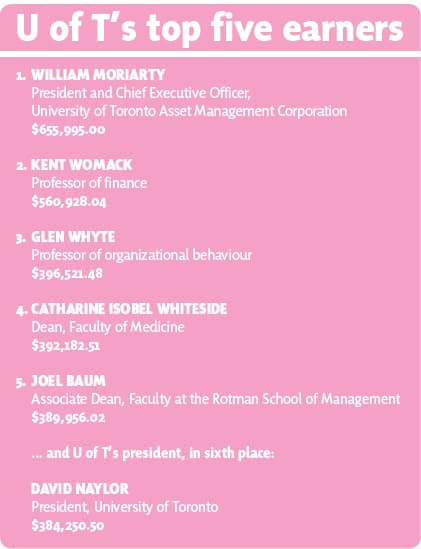The release of the province’s annual “Sunshine List” of top public sector earners has revealed that U of T’s highest paid staff is William Moriarty, president and chief executive officer for the University of Toronto Asset Management Corporation (UTAM). This year, Moriarty earned $655,995.00, a 6.2 per cent decrease from the last year’s chart-topping $697,020.00.
Moriarty joined the UTAM in 2008, where he was responsible for overseeing investments with the university’s sizeable endowment. In the global financial crisis that same year, its hedge fund investments lost the university $528.1 million. This led to cutbacks in faculties that relied on endowed teaching positions, as well as endowed bursaries and grants.
Kent Womack, a professor of finance and Manulife Chair in Financial Services, was the second highest earner with $560,928.04, a $359,928 or 179 per cent increase from $201,000.04. Glen Whyte, a professor of organizational behaviour, followed at $396,521.48.

To cap off the top five, Catharine Isobel Whiteside, dean of the faculty of medicine, raked in $392,182.51. Joel Baum, an associate dean of faculty and professor of strategic management, earned $389,956.02.
David Naylor, president of U of T, came in with sixth place at $384,250.50.
“The performance of every faculty member is assessed on an annual basis, and increases are based on that merit assessment, as well as on negotiated across-the-board settlements,” said Laurie Stephens, a spokesperson for the administration in an email response.
Stephens pointed out that U of T’s faculty has won 21.7 per cent of Canada’s most prestigious research awards, despite representing less than seven per cent of all Canadian professors.
“As one of the world’s top-ranked research universities, U of T must offer competitive salaries to attract and retain talented faculty,” she said.
James Nugent, former chief spokesperson for CUPE 3902 Unit 1, said he had “mixed feelings” about the public release of the list, although he agrees professors should be compensated depending on the quality of their research.
Nugent was particularly critical of the wage disparity between administrators and post-graduate students.
He referred specifically to last month’s collective agreement deal, which set post-graduate workers wage increase for the next year at 1.75 per cent. This, Nugent pointed out, is not enough to keep up with rising cost of living with a 3.1 per cent inflation rate.
“You have someone like the provost [Cheryl Misak] giving herself a 4.1 per cent [salary] increase while at the same time coming to the bargaining table telling us that this is tough times for the university financially,” Nugent said. “It strikes me as very hypocritical.”
Danielle Sandhu, president of the UTSU, expressed concern regarding the wage discrepancies on the list. “The data in the [sunshine list] suggests a significant and potentially growing disparity between administrators and faculty, and a disparity between faculty members in different fields,” she said in an email response. “The numbers challenge the idea that the administration does not have the money to provide fair wages to all staff and instructors.”
Nugent tends to agree. “The very same people that are forcing the lowest paid workers to decrease their wages in real terms, are giving themselves 4, 6, 9 per cent wage increases, which is unacceptable.”

